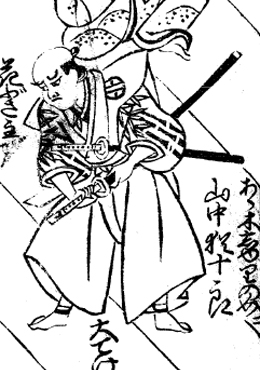| |
Dates of birth and death unknown. He was recorded for the first time in 1702, when he performed as a wakaonnagata
in Edo at the Ichimuraza. His first stage name was Uemura Tatsusabur˘ I but we could not clarify his relationship to the Uemura clan.
Was he a disciple of Uemura Kichiya II or Uemura Kichiya III? He settled in Kamigata,
became katakiyaku and took the name of Yamanaka Naoemon in ďsaka in the 11th lunar month of 1708,
performing in the kaomise drama "Tate Eboshi Daijin Bashira" which was produced by Arashi Sanjűr˘ I.
He went back to Edo in Fall 1710, became tachiyaku and performed in the 11th lunar month of 1710 at the Nakamuraza in the kaomise drama "Shinsen Kazanin".
His stay in Edo was very short as he went back in Spring 1711 to ďsaka, where he switched back to katakiyaku roles.
He settled in Ky˘to in Fall 1717.
He became tachiyaku and took the name of Yamanaka Naojűr˘ in the 11th lunar month of 1717,
playing the role of the wakadono Naniwazu Harunoj˘ in Sadoshima Sabur˘zaemon's kaomise drama "Iwao no Matsu Manbai no Midori",
which was produced by Miyako Mandayű in his theater. He became jitsuaku and performed in the 11th lunar month of 1718 in Ky˘to at Hayagumo Ch˘dayű's theater in the kaomise drama "Ch˘seiden Kogane no Ishizue",
which was produced by Sakakiyama Shirotar˘ I.
He became katakiyaku in the 11th lunar month of 1720 and performed in Ky˘to in the kaomise drama "Jűni Ch˘shi Megumi no Kodakara",
which was produced by Sakakiyama Shirojűr˘.
He switched back to jitsuaku roles and played in the 11th lunar month of 1721 in Ky˘to at Hoteiya Umenoj˘'s theater the role of Harada Ikuemon in the kaomise drama "Banshiki Kogane no Miyako",
which was produced by Ogino Yaegiri I.
His rank in the 1722 Ky˘to hy˘banki,
jitsuaku section, was j˘-j˘ (superior - superior) [visual].
No record afterwards.
|
